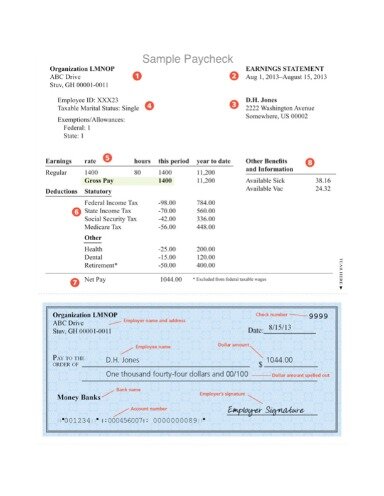Contents:


You cannot afford inaccurate information because ROP also aids in determining your customers’ demand. There is a risk that you may either overstock or have nothing to sell if you base your ROP on inaccurate information. A company reduces the danger of stockouts by using the reorder point to buy new stock on a timely schedule. A reorder point may help streamline your purchasing department’s efforts when utilized appropriately.
- Variable reorder point is a technique for calculating the ideal time to reorder a product by taking into consideration both the lead time for a product and the product’s consumption/sales rate.
- It lets the ordering manager or management software know that it’s time to refill an order for items to reach your store before the rest of your inventory depletes.
- Safety stock times can vary during peak seasons and may have to be recalculated periodically.
This can take the guesswork out of reordering and help you keep your shelves stocked with the products your customers need. The goal is to find the perfect balance of inventory levels so that you have enough stock to meet customer demand without tying up too much capital in inventory. Understanding and using reorder point is essential to maintain optimized inventory levels. The quantity of inventory at which you must reorder is known as your reorder point. You may prevent stockouts and maintain the smooth operation of your company by being aware of and leveraging your reorder point.
Best Point-of-Sale (POS) Systems and Software
Indeed, when making an order, one has to anticipate the stock already on its way. For consistency of the analysis, the input settings need to be extracted at the same time. Based on the conventions we follow in this sheet, this time can be either at the very end of Day 0 or just before the beginning of Day 1. Then, those settings are validated against sales data that happen afterward. The store sells twelve machines every week, and it’s open from Monday to Saturday. It means that in a normal week, the store would sell around two washing machines per day.
Reducing the pinball loss for your inventory can only be achieved through better forecasts . As a rule of thumb, a reduction of 1% of the pinball loss will generate between 0.5% to 1% of safety stock reduction while preserving the same frequency of stock out. ShipBob’s platform doesn’t just help with inventory control and forecasting, but generates powerful analytical reports covering all areas of your business. You can get inside the numbers and find new ways to improve supply chain efficiency. Multiply the average number of daily orders by the average lead time.

Storing too much inventory eats up your budget in terms of warehousing costs and available capital, but you also need enough inventory to account for unexpected demand or supply problems. Implementing dedicated inventory management software or an MRP system gives companies access to a host of advanced tools and functionalities, including but not limited to setting reorder points. These solutions hugely simplify and elevate data-driven decision-making and give manufacturers and distributors the tools to decisively increase overall efficiency. As effective as it can be, it pays to stress once more that the ROP model is not the be-all and end-all of inventory management.
Why is it important to know your reorder point?
For figuring out an optimal amount of units – and to help improve operations and reduce costs – figure out your economic order quantity. You might have a single item that sells consistently, requiring you to keep it stocked often and at higher numbers than other products. For example, Apple’s iPhone is far more popular than any other product they produce, so its daily sales velocity is likely higher than their laptops or iPads. The daily sales velocity, or the average number of units you sell per day, differs for everything you sell. If you’re using multiple items in your workflow and they are required they should be factored into your formula.
Get started tomultiple streams of income with a free real-time demo to learn more about Finale Inventory. Going back to “View Stock,” you will see your current stock reflects the changed number of available pies. Then, divide your standard deviation by the number of orders which gives you a standard deviation of 0.56.
If you want to know how to calculate the reorder point, the formula for reorder point calculation is, quite simply, the sum of the lead time demand and safety stock. When you manage your inventory with SOS Inventory software, SOS will automatically calculate them for all your materials. The first is the lead time, safety stock, which is the extra inventory a business keeps on hand in case of spikes in demand or unexpected delays in receiving new inventory.
The second is the sales rate, which is the average amount of an item that is sold over a specified period of time. And the rest one is the lead time, which is the amount of time it takes to receive new inventory from the time an order is placed. The reality of inventory management is that achieving 99.9% service level requires an enormous amount of inventory. Indeed, 99.9% means that you don’t want to afford more than 1 day of stockout every 3 years. With the classical safety stock formula, using a very high service level does not generate massive stocks.
Reorder points are a valuable tool for making sure you have sufficient inventory on hand for your customers without having so much inventory that it becomes costly and unmanageable. Investments in setting up smart reorder points today can yield dividends in efficiency for years to come. However, supply and demand can fluctuate, and outside factors can impact lead time.
Then you will calculate the safety stock:
Using the reorder point formula, you can calculate that your reorder point is 120 units. The moment your inventory levels fall below this number, you will need to place a new order. Depending on what you’re looking into, the average daily usage is the number of raw materials you consume or finished goods you sell in one day.
Merit Over Identity – City Journal
Merit Over Identity.
Posted: Tue, 11 Apr 2023 07:00:00 GMT [source]
Your retail inventory management system will let you know when it’s time to reorder inventory – and may even be able to do it for you. Lead time demand is the number of products you expect to sell between placing an order for more inventory and receiving that order. To calculate this number, you will need to determine your average daily sales or usage rate for the product, as well as the supplier’s lead time to deliver it.
What Is a Reorder Point (ROP)?
The strength of the approach can be most simply explained by the fact that, in statistics, direct measurements trump indirect measurements. Mean forecasts are many other usages beyond the strict reorder point calculation. For example, when it comes to visualize the forecasts, quantiles tend to be harder to comprehend. Since the local supplier has a smaller lead time, the second reorder point is lower than the first one. Intuitively, orders are made to the local supplier, only when it becomes highly probable that a stock-out will be hit and that it is too late already to order from the distant supplier.
2045 Machines Will Shop For Humans-Srinath Sridharan – BW Businessworld
2045 Machines Will Shop For Humans-Srinath Sridharan.
Posted: Thu, 20 Apr 2023 19:07:52 GMT [source]
ShipBob helps ecommerce brands manage inventory, forecast demand, pack orders, reduce shipping costs, and deliver on customer expectations. With a network of fulfillment centers around the United States and technology that’s integrated with the leading ecommerce platforms, ShipBob helps brands improve their shipping strategy. It’s not enough to know the average demand for a product, as that demand can increase suddenly or problems with a supplier can prevent you from restocking inventory as quickly as you expected. Safety stock, as the name suggests, is the extra “just in case” inventory you keep on hand to anticipate variability in demand or supply. Lead time is the number of days between when you place a purchase order with your manufacturer or supplier for a product and when you receive the product. Your lead time will be longer if your supplier is overseas as compared to a domestic or in-house production facility.
When implemented correctly using reorder points will ensure you’ll always stay at the perfect level of stock without ever dealing with stock outs. Your safety stock will be there just in case you experience any unforeseen shipping delays. When the quantity on-hand for Ghost glasses hits 38, Archon Optical knows to place a purchase order for more.
Your Guide to Growing a Business The tools and resources you need to take your business to the next level. Early works on the question date from the late 1970s, but for recent materials see Koenker, Roger Quantile Regression, Cambridge University Press. Multiply the maximum number of daily orders by the maximum lead time that may be required in case of supplier delays. A reorder point is the lowest number of units of an item that a company needs to have in stock to make sure they do not run out and can keep fulfilling orders. Now, let’s get to the second point of the calculations, which is the safety stock. Average Lead Time – The average number of days between ordering a product from your supplier and having it on your shelves.
Your reorder point should make production in your business flow, not stop and start. Demands are not fixed, it’s volatile; You need to calculate demands based on trends. Sales rate is one of the key factors in calculating your reorder point. By understanding your sales rate, you can more accurately forecast future demand and ensure you have the inventory on hand to meet customer needs. The reorder point is important because it helps businesses in keep your inventory in a balanced levels which to minimize costs, maximize profits, and business capability. Stockouts can lead to lost sales, unhappy customers, and a hit to the business’s reputation.
The more complicated part is determining what those reorder points are, which is a function of the variables that go into a reorder point calculation. In this theoretical world, you’d be running a business with no need for inventory, placing orders as the customers come to you and having your customers served instantly. First, reorder points allow a business to make fast, low-stress, data-driven decisions about ordering inventory, without having to start from first principles every time. A simple, rules-based approach saves time and reduces the possibility of costly mistakes in inventory management.
Could you please explain what are the different variables that can affect the reorder point or level from within the organization? Or what are the factors that may hamper the warehouse or distribution center from placing a reorder or effect it in any way. Looking for another system today, but looks like the whole world has a knee-jerk reaction and blurts out MRP at the drop of a hat. Are you able to recommend any notable such systems on today’s market. Hi Lesego, the way we’ve defined the reorder point here is to basically treat it like a minimum level. So once you dip below the reorder point , then that is when you should order more stock.
Raw MaterialsRaw materials inventory is the cost of products in the inventory of the company which has not been used for finished products and work in progress inventory. Raw material inventory is part of inventory cost which is reported under current assets on the balance sheet. Regular audits spot trouble sooner and identify opportunities for improvements. Be mindful of increased delivery times or growing quality control issues.
The most important and sometimes hardest part of calculating reorder points accurately is that you need reliable data for supply chain planning and provide an accurate picture of customer demand. If the data is off, then the calculation will be inaccurate and you may end up with too much or too little stock. The sales or manufacturing rate, or demand rate, also differs per item and is a function of consumption over time. It is usually the average daily usage or average sales per day of an item.


There are 0 comments